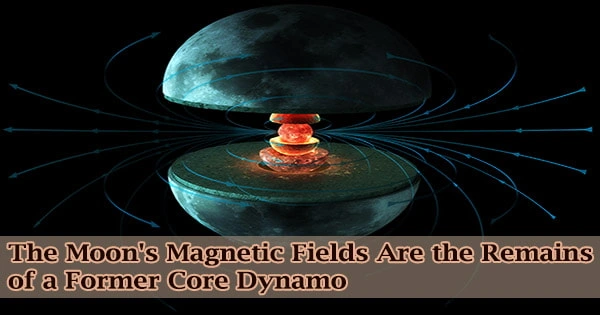Currently, it cannot be observed from Earth that the moon has an interior magnetic field. On its surface, there are isolated areas with a magnetic field that is extraordinarily powerful that can be up to several hundred kilometers in size.
Measurements on rocks from the Apollo missions have demonstrated this. Since then, scientists have been baffled as to where these magnetic spots came from. One theory holds that they are somehow the lingering effects of a long-gone core magnetic field. Likely comparable to what is currently seen on Earth now.
Iron is molten and solid in this core, and the revolution of the core creates the earth’s magnetic field. Research continues on the reasons behind the extinguishment of the Moon’s inner field.
Another well-known idea about the moon’s local magnetic regions contends that they are the outcome of processes that magnetize the surface of the moon as a result of impacts from large bodies.
The Moon must have formerly possessed an internal core dynamo, according to a study that was just published in the journal Science Advances. The researchers reached their findings by using intricate computer simulations to refute this second notion.
It is the outcome of extensive international collaboration involving MIT, GFZ-Potsdam, UCLA, the University of Michigan, the Australian Curtin University, and the University of Potsdam.
The second hypothesis was reinforced, among other things, by the discovery of sizable, powerful magnetic patches on the opposite side of the moon, just across from significant lunar craters.
How exactly the magnetic spots were formed still requires more research. But now it is clear that at some point in time an internal magnetic field of the Moon had to be present for this to happen. In addition, this study can help us to better understand the nature of the dynamo-generated magnetic field and the dynamo process on Earth, the outer planets and exoplanets.
Professor Yuri Shprits
It was thought that they came from: The Moon, unlike the Earth, does not have an atmosphere to shield it from meteorites and asteroids, so when they strike it with full force, they can ionize and pulverize the material on its surface.
This process produces a plasma cloud of charged particles that swirls around the Moon, compressing the magnetic solar wind in space and enhancing its magnetic field. The moon itself develops a magnetic field simultaneously as a result of the solar wind.
All these fields are increased at the surface opposing the collision, producing the observed magnetism in the crustal rock.
Researchers have now modelled the impact, including plasma production, plasma propagation around the moon, and the path of the field induced in the moon’s interior, using examples of several well-known Moon craters like the one we recognize as its “right eye.”
They simulated a variety of impact scenarios using software that was first created for space physics and space weather purposes.
The researchers were able to demonstrate that the huge field strengths initially predicted and found on the moon could not be produced by the magnetic fields alone being amplified by impacts and ejected material:
The magnetic field that results is a thousand times weaker than what is required to account for the data. However, this does not imply that these effects are absent; they are simply comparatively modest.
The simulations specifically demonstrated that the magnetic field within the moon loses a significant amount of energy through dissipation due to turbulence in the mantle and crust and that the field amplification by the plasma cloud on the rear side of the impact is more likely to occur above the crust.
“How exactly the magnetic spots were formed still requires more research. But now it is clear that at some point in time an internal magnetic field of the Moon had to be present for this to happen,” says Yuri Shprits, Professor at the University of Potsdam and head of the Magnetospheric Physics Section at GFZ-Potsdam.
“In addition, this study can help us to better understand the nature of the dynamo-generated magnetic field and the dynamo process on Earth, the outer planets, and exoplanets.”





